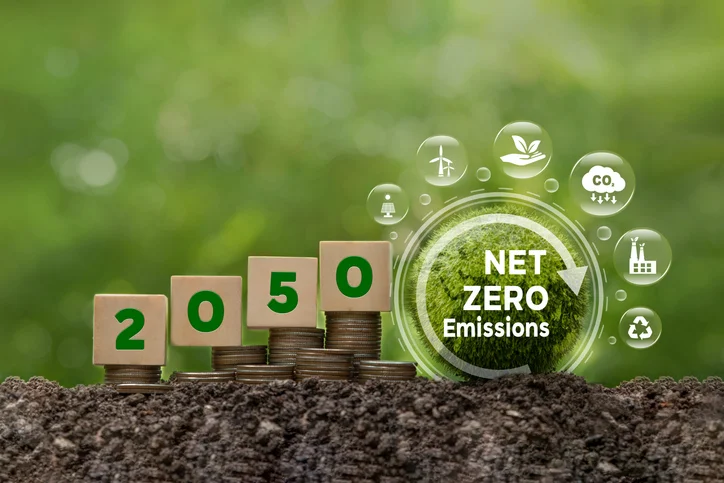India’s NDC Goals & Net-Zero Commitments under the Paris Agreement
India, as a key player in global climate negotiations, has updated its Nationally Determined Contributions (NDCs) under the Paris Agreement to align with its long-term commitment to achieving net-zero emissions by 2070. Given India’s economic aspirations and energy needs, its approach to climate action is a balance between sustainability and development.
India’s Nationally Determined Contributions (NDCs) under the Paris Agreement
India submitted its updated NDCs in August 2022 to the UNFCCC, strengthening its previous commitments made in 2015. The key targets include:
- Emission Reduction Targets
- India has committed to reducing the emissions intensity of its GDP by 45% by 2030, relative to 2005 levels.
- This goal is an enhancement from India’s previous target of a 33-35% reduction in emission intensity by 2030 (as per the 2015 NDC).
- The focus is on energy efficiency, industrial decarbonization, and clean energy transitions.
- Renewable Energy Targets
- 50% of India’s total installed electricity capacity will come from non-fossil fuel sources by 2030.
- This commitment builds on India's ambitious renewable energy target of 500 GW of non-fossil fuel capacity by 2030.
- India is focusing on expanding solar, wind, hydro, and nuclear energy.
- Carbon Sink Enhancement
- India aims to increase its forest and tree cover to create an additional carbon sink of 2.5 to 3 billion tonnes of CO₂ equivalent by 2030.
- This goal is being pursued through initiatives such as:
- National Afforestation Programme (NAP)
- Green India Mission
- National Adaptation Fund for Climate Change (NAFCC)
- Adaptation and Resilience
- Recognizing its vulnerability to climate change, India has
outlined adaptation measures in
sectors such as:
- Agriculture: Climate-resilient crop varieties, better irrigation systems.
- Water Resources: Efficient water management policies.
- Disaster Risk Reduction: Early warning systems and infrastructure resilience.
- Public Health: Heatwave preparedness programs and pollution control.
- Recognizing its vulnerability to climate change, India has
outlined adaptation measures in
sectors such as:
- Climate Finance & Global Equity
- India has consistently emphasized the principle of Common But Differentiated Responsibilities (CBDR) under the UNFCCC framework.
- India advocates for climate finance and technology transfer from developed nations to assist in achieving its climate goals.
India’s Net-Zero Commitment by 2070
At COP26 in Glasgow (2021), Prime Minister Narendra Modi announced India’s net-zero target for 2070, making India one of the last major economies to commit to carbon neutrality. The approach to achieving net-zero is based on a multi-sectoral strategy:
- Phasing Down Fossil Fuels
- India is the world's third-largest emitter of CO₂, primarily due to its reliance on coal-based power generation.
- The government is working towards:
- Phasing down inefficient coal plants.
- Investing in carbon capture and storage (CCS) technologies.
- Expanding renewable energy capacity to reduce dependency on coal.
- Renewable Energy Expansion
- India aims to achieve 500 GW of non-fossil energy capacity by
2030, including:
- Solar Energy: India’s solar power capacity has increased from 6 GW in 2014 to over 70 GW in 2023.
- Wind Energy: Offshore wind projects are being explored.
- Hydropower & Nuclear Energy: India is expanding its hydropower projects and investing in nuclear energy.
- India aims to achieve 500 GW of non-fossil energy capacity by
2030, including:
- Green Hydrogen Mission
- The National Green Hydrogen Mission (2023) aims to:
- Make India a global hub for green hydrogen production.
- Reduce reliance on fossil fuels in sectors like steel, transportation, and chemicals.
- India aims to produce 5 million tonnes of green hydrogen annually by 2030.
- The National Green Hydrogen Mission (2023) aims to:
- Electric Vehicles (EVs) and Sustainable Mobility
- India’s EV penetration is targeted to reach 30% of private vehicles and 70% of commercial vehicles by 2030.
- Key initiatives:
- Faster Adoption and Manufacturing of Hybrid and Electric Vehicles (FAME) Scheme.
- Battery Swapping Policy to promote charging infrastructure.
- Phasing out internal combustion engine (ICE) vehicles in the long run.
- Industrial Decarbonization
- Sectors such as steel, cement, and chemicals are among the highest emitters in India.
- The Perform, Achieve, and Trade (PAT) scheme is designed to enhance energy efficiency and reduce emissions in these industries.
- Carbon pricing and emissions trading mechanisms are under development.
- Agriculture and Carbon Sequestration
- Sustainable agriculture initiatives:
- Zero Budget Natural Farming (ZBNF) and organic farming techniques.
- Agroforestry and carbon sequestration projects.
- Sustainable agriculture initiatives:

Key Climate Policies and Initiatives: India’s Net-Zero Strategy
India’s commitment to net-zero emissions by 2070 is backed by a range of policy frameworks, regulatory mechanisms, and strategic initiatives. These policies address energy efficiency, renewable energy, carbon pricing, sustainable urbanization, and air pollution control. Below is a detailed breakdown of India’s key climate policies and initiatives:
Energy Efficiency & Conservation Policies
Energy efficiency plays a crucial role in reducing India’s overall carbon footprint. The government has implemented laws and programs to ensure efficient energy use in industries, buildings, and appliances.
- Energy Conservation Act, 2001
- The Energy Conservation Act (ECA), 2001, is the foundational law for energy efficiency in India.
- It mandates energy efficiency norms for industries, buildings, and commercial establishments.
- Bureau of Energy Efficiency (BEE) oversees implementation.
- Industries consuming large amounts of energy must adhere to minimum efficiency standards.
- Perform, Achieve, and Trade (PAT) Scheme
- Launched in 2012, under the National Mission for Enhanced Energy Efficiency (NMEEE).
- Aims to improve energy efficiency in energy-intensive industries.
- Companies that exceed their energy-saving targets earn tradable Energy Saving Certificates (ESCerts).
- These certificates can be sold to industries that fail to meet their targets.
- State Energy Efficiency Action Plans (SEEAP)
- State-level programs designed to reduce power consumption.
- States are encouraged to set energy efficiency targets in key
sectors such as:
- Buildings
- Agriculture
- Transport
- Industries
- Energy Efficiency in Appliances: Standards & Labeling Program
- Introduced by BEE to promote energy-efficient appliances.
- Star-rating system (1 to 5 stars) for electrical appliances such as air conditioners, refrigerators, and LED bulbs.
- Ujala Scheme: Distributed over 360 million LED bulbs, leading to a 36 million-ton reduction in CO₂ emissions annually.













